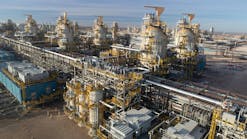One striking fact about the recent megamergers is how gas portfolios seem to grow in importance through the deals.
Royal Dutch/Shell created the matrix: huge gas reserves and an array of processes-including LNG, gas-to-liquids (GTL), petrochemicals, and hydrogen production-to exploit them (OGJ, Nov. 24, 1997, p. 29).
With the formation of Exxon Mobil Corp., a leading GTL contender with an array of petrochemical processes (Exxon) will be paired with a leading LNG producer (Mobil) in a company with vast gas reserves (OGJ, Dec. 7, 1998, p. 37).
As BP Amoco PLC takes over ARCO, this pattern will be repeated. Intriguingly, a GTL pilot plant was one of the offers made to the Alaskan government by BP Amoco to help gain acceptance of the deal (see related story, p. 27).
These giants will be able to squeeze LNG and petrochemical production costs more than ever. But it would be interesting to discover just how important GTL capability was as a driving factor behind the mergers, as supermajor CEOs gauged future transport fuel trends.
New impetus
GTL technology would give these giants extra firepower in the inevitable fight for market supremacy as environmental limits become eye-wateringly tight.
Mark Agee, president of Syntroleum Corp., Tulsa, told a recent San Francisco conference that a convergence of events in the automotive and fuels industries, coupled with an abruptly tightening environmental noose, is creating a crucial role for the emerging GTL industry.
"The desire to monetize stranded gas reserves was the original motivation to develop GTL technology," said Agee.
"But the crucial role of low-sulfur fuels in advancing the causes of cleaner air and greater fuel economy will likely trigger the first commercial projects and give the nascent GTL industry a giant push forward. Supplies of several 100,000 b/d of essentially sulfur-free fuel may be needed by the middle of the next decade.
"Two years ago, conventional wisdom was that synthetic fuel would never be sold neat, that it would be used only for upgrading higher-sulfur fuels.
"The US Environmental Protection Agency's recent proposal requiring a separate, ultraclean diesel for city use would change everything. It would create instant, significant demand for neat synthetic fuels."
Inevitable
Of the GTL specialists, South Africa's Sasol Ltd. has commercial capacity up and running and has established a GTL joint venture with Chevron Corp. Syntroleum has licensed its technology to a number of majors, including ARCO (OGJ, June 21, 1999, p. 31).
Of the megamajors, BP Amoco-ARCO is the latest to join the fray with its Alaskan pilot proposal. Already, Shell has a 12,500 b/d GTL plant operating in Malaysia and plans a 50,000 b/d unit in Bangladesh; Exxon is considering 100,000 b/d plants in Alaska and Qatar.
Agee concluded, "The clamor for natural gas-based synthetic designer fuels has a ring of inevitability because of its source. The noise is not coming from the ranks of GTL technology suppliers and producers but from others who are set on exploiting these unique fuels to solve their own problems."

